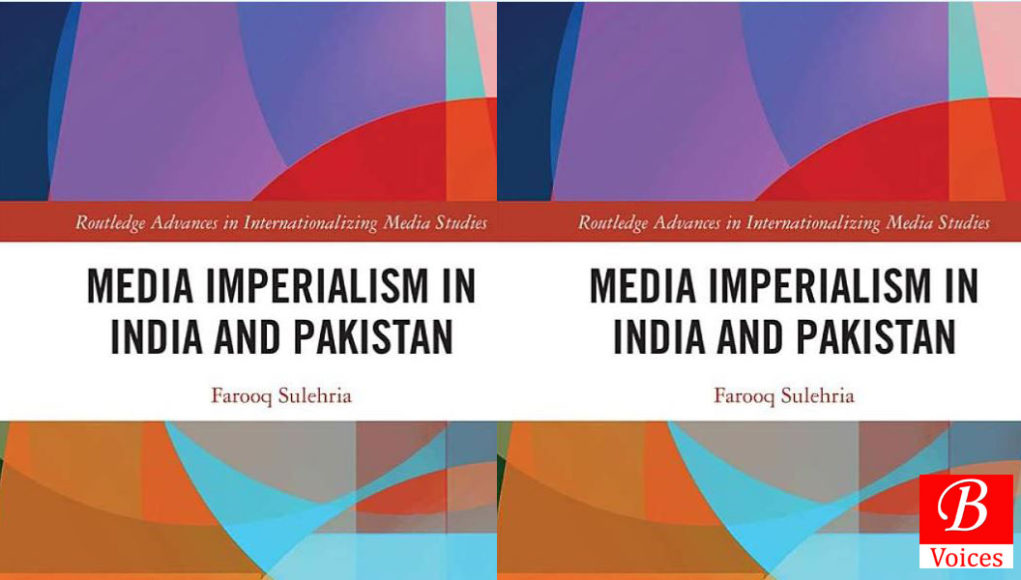Anisa Shabir
Globalisation has made the peripheral states more dependent on the centre- the dominant West. Media Imperialism in India and Pakistan by Farooq Sulehria, explores the mediascape of India and Pakistan, explaining the factors leading to ever-increasing dependency of media sector of both countries in the present-day world.
The “$19 billion dollar” Media and Entertainment (M&E) industry of India is a sign of growing economy. A booming business. Farooq Sulehria dissects the façade of globalisation, explaining it not as a sign of development, but rather a process prompting dependency on the West: USA, UK, et al.
The author explains the above-mentioned notion by laying emphasis on media imperialism. The book revolves around this term, which he believes has disappeared from the media discourse. Media imperialism is “the capitalist exploitation of dependent media markets by the metropolitan West” and “the periphery’s explicit dependency on imperial metropolitan countries.”
It has six chapters. First chapter introduces the problem, after which, the second chapter delves into the mediascape of India.
India got its state-run television in 1959, with the help of UNESCO. Doordarshan’s agenda, or DD for short, was the development of the country, focusing on educational programs. 1970 onwards, DD embraced commercialization to expand its horizon and engaged in entertainment section.
1980s: a period of boom for DD. More advertisements and sponsored programs increased the revenue for the state-run television. “More than 80% of the 3.6 million Indian television viewers at the time tuned into Hum Log every week.” Nestle India was the sponsor and it “paid for the telecast fee as well and production cost of Hum Log.”
The arrival of VCR and cable threatened the monopoly of DD. “CNN effect during the First Gulf War” also marked this period. The purchase of ASIASAT1 by Hutchison group, a geostationary satellite over the Indian ocean, made it possible to downlink STAR Plus to India. The launch of Zee TV, a joint venture between Star and Zee, became the first privately owned channel of India. It sought a slot on ASIASAT1.
The number of privately-owned channels increased manifold in 2000s. “From 40 in 2001”, the number went as high as “822 by June 2017.” Farooq stresses this by saying, “the channels sprouted on airwaves like green weed.”
This is where the author wants the readers to pause. He gets critical. The major private channels were either joint ventures between the global media conglomerates and the local media players, or the former had more shares than the latter. The Hutchison group sold “63.6% equity stake in Star to Rupert Murdock’s News Corporation for $525 million.” Other privately-owned top channels also tell a grimmer story. Colors is a joint venture between Network 18 and Viacom (a global media conglomerate). The kid’s channels, the likes of Nickelodeon, Cartoon Network, are the subsidiaries of Viacom, Time Warner, respectively. Viacom, in this case, is a partner of Network 18.
The only exception that seems to have resisted the penetration of foreign media giants is the news genre, which due to a legislation was resisted, and thus prevented the “Murdochisation of Indian politics,” though New Delhi Television (NDTV) was initially the partner of News Corporation before parting ways.
The commercialization has also increased the TRP game. In India, Nielson and Kantar, the global audience measurement conglomerates, owns TAM-Nielson, which is active in TRP measurement. Global advertising monopolies also have established a firm foothold. Clarion-McCann, Lintas, and Grant Advertising are the top foreign advertising players.
Chapter third navigates the mediascape of Pakistan. By drawing a comparison, there seems to be no domination by global media conglomerates in the section of news channels, save in the case of CNBC Pakistan, and general entertainment channels (GECs), because they have to seek “landing rights” from Pakistan Electronic Media Regulatory Authority (PEMRA). ZEE TV, Star Plus dominate the airwaves in the country, despite restrictions, aired by the local cable operators (LCOs), and sometimes local channels give space to content from across the border, highlighting the “sub-imperial” role of India in center-periphery paradigm. The airing of Turkish drama serials is also the unique case. In terms of advertising, TV sets production, switching to digital system from analogue, the dependency on West by both the countries is absolute.
The book furthers the argument of dependency factor by focusing on “Media Education and Training.” The media studies departments in the colleges and universities of peripheral states have adopted the education setup of USA. The penetration of global media giants has compounded the dependency, because to be able to participate in the system made by them, let’s say as an employee at one of the channels owned by them, one requires the education and training that could meet the criteria. Students getting enrolled in the universities abroad through scholarships is also a factor discussed in the book. In other words, USA has appeared as a “college professor to the world.”
Globalization has also increased the level of corruption in the “Indian and Pakistani TV systems” because the process “replaced public interest TV with commercial ones.”
Media Imperialism in India and Pakistan is the much-needed research work in media studies that fills the gap. It gives a unique perspective on why globalization has appeared as a stimulus for creating more problems in mediascape of peripheral states, rather than being a harbinger of development in the developing world. Moreover, it sets a precedent for the media departments of universities of India and Pakistan to break free from the decades old curriculum and make new breakthroughs in research work.
Disclaimer: Views expressed in this article are those of the author and Balochistan Voices not necessarily agrees with them.
Share your comments!








